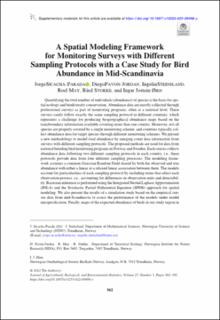A Spatial Modeling Framework for Monitoring Surveys with Different Sampling Protocols with a Case Study for Bird Abundance in Mid-Scandinavia
Pavòn-Jordàn, Diego; Steinsland, Ingelin; May, Roelof Frans; Stokke, Bård Gunnar; Øien, Ingar Jostein; Sicacha-Parada, Jorge
Peer reviewed, Journal article
Published version

Åpne
Permanent lenke
https://hdl.handle.net/11250/3046058Utgivelsesdato
2022Metadata
Vis full innførselSamlinger
- Publikasjoner fra CRIStin - NINA [2364]
- Scientific publications [1392]
Originalversjon
Journal of Agricultural Biological and Environmental Statistics. 2022, 27 (3), 562-591. 10.1007/s13253-022-00498-ySammendrag
Quantifying the total number of individuals (abundance) of species is the basis for spatial ecology and biodiversity conservation. Abundance data are mostly collected through professional surveys as part of monitoring programs, often at a national level. These surveys rarely follow exactly the same sampling protocol in different countries, which represents a challenge for producing biogeographical abundance maps based on the transboundary information available covering more than one country. Moreover, not all species are properly covered by a single monitoring scheme, and countries typically collect abundance data for target species through different monitoring schemes. We present a new methodology to model total abundance by merging count data information from surveys with different sampling protocols. The proposed methods are used for data from national breeding bird monitoring programs in Norway and Sweden. Each census collects abundance data following two different sampling protocols in each country, i.e., these protocols provide data from four different sampling processes. The modeling framework assumes a common Gaussian Random Field shared by both the observed and true abundance with either a linear or a relaxed linear association between them. The models account for particularities of each sampling protocol by including terms that affect each observation process, i.e., accounting for differences in observation units and detectability. Bayesian inference is performed using the Integrated Nested Laplace Approximation (INLA) and the Stochastic Partial Differential Equation (SPDE) approach for spatial modeling. We also present the results of a simulation study based on the empirical census data from mid-Scandinavia to assess the performance of the models under model misspecification. Finally, maps of the expected abundance of birds in our study region in mid-Scandinavia are presented with uncertainty estimates. We found that the framework allows for consistent integration of data from surveys with different sampling protocols. Further, the simulation study showed that models with a relaxed linear specification are less sensitive to misspecification, compared to the model that assumes linear association between counts. Relaxed linear specifications of total bird abundance in mid-Scandinavia improved both goodness of fit and the predictive performance of the models. Supplementary materials accompanying this paper appear on-line. Data integration; Joint species distribution models; Bayesian statistics; Latent Gaussian Models; Gaussian Random Fields